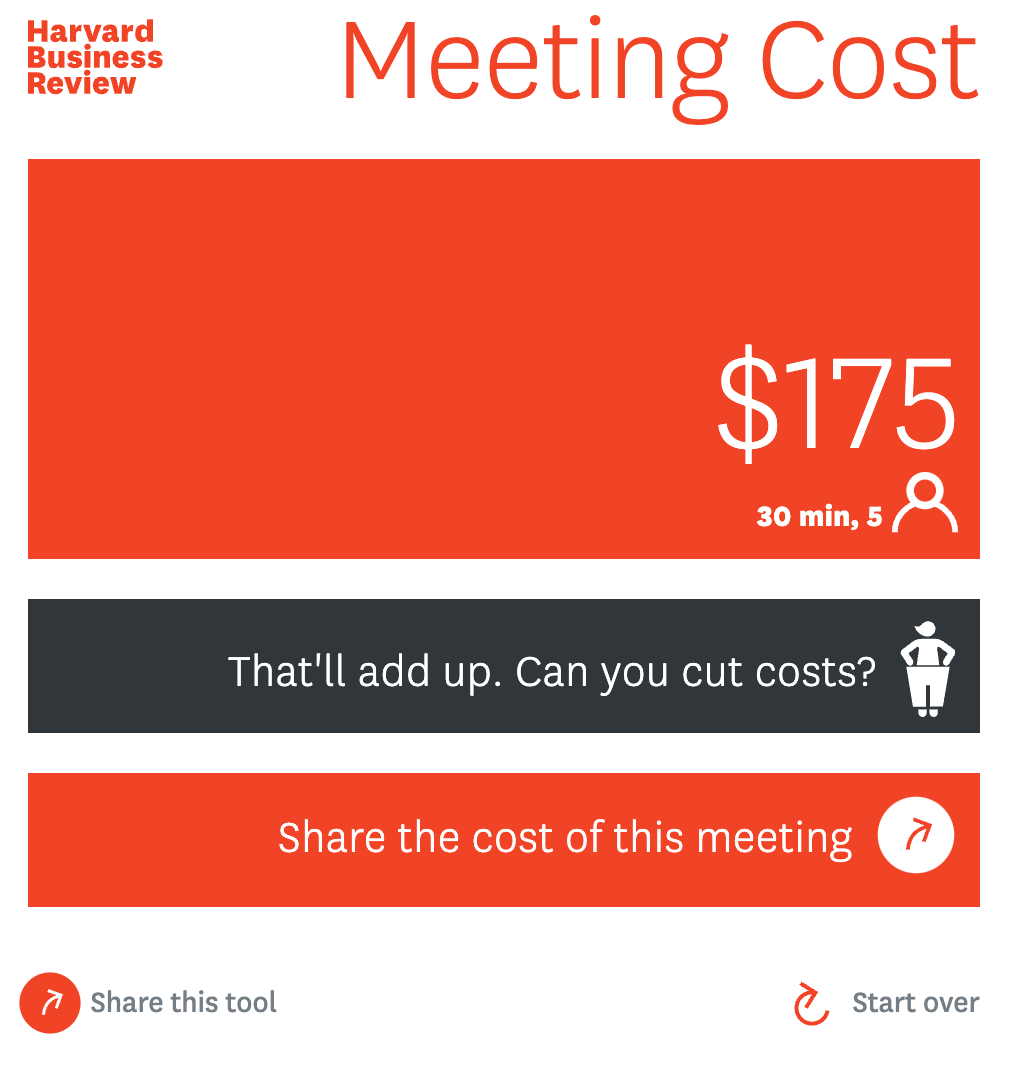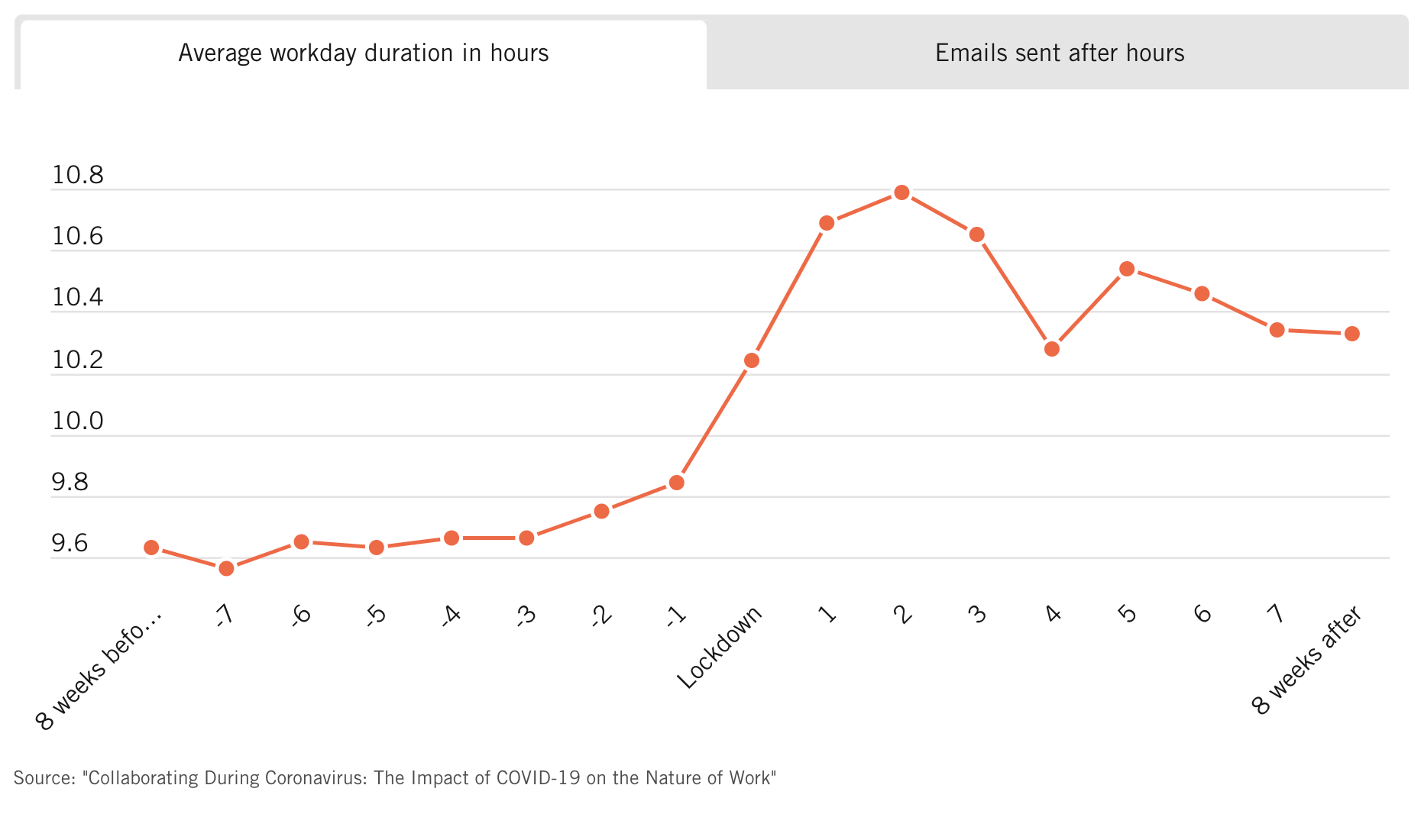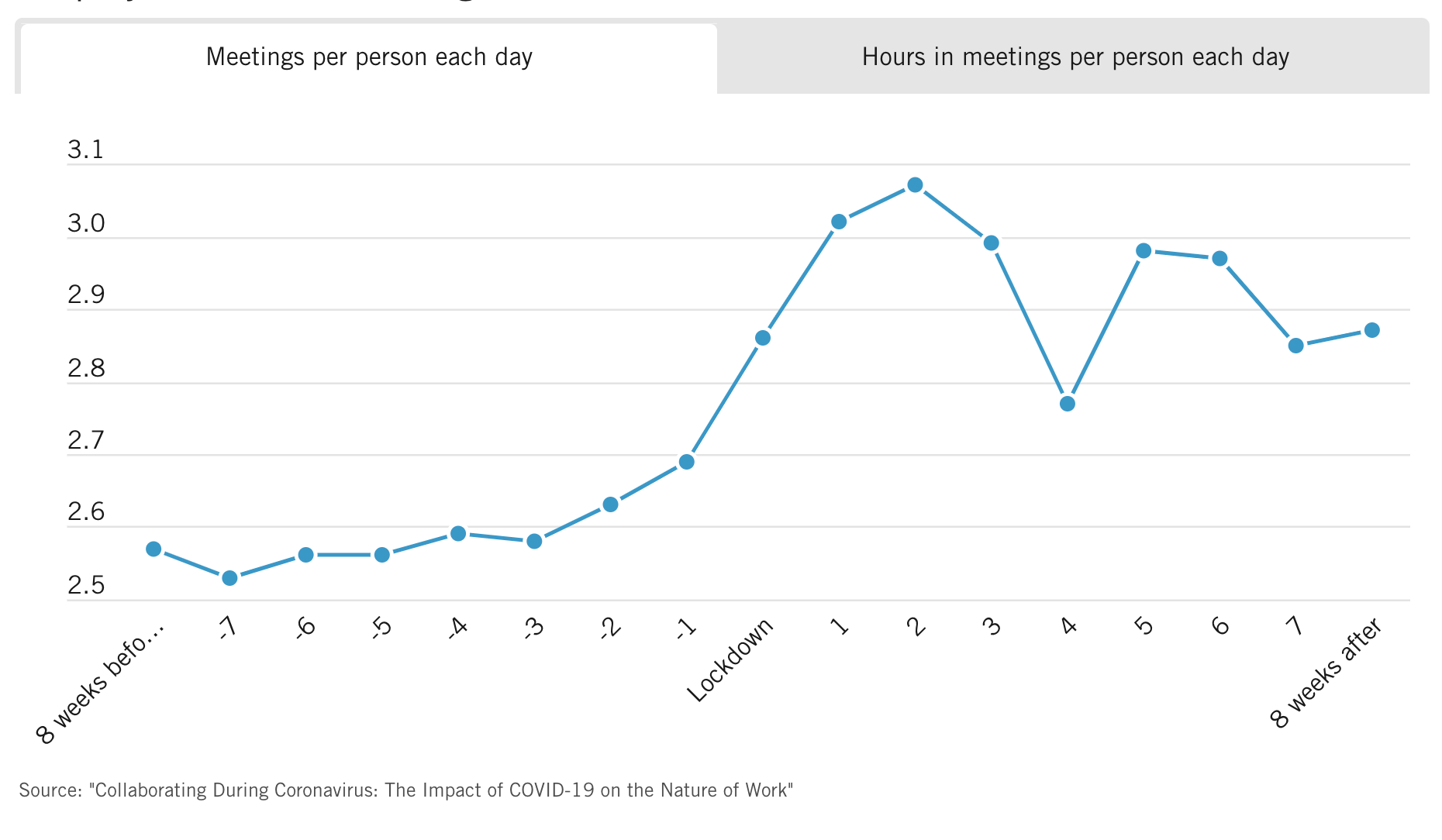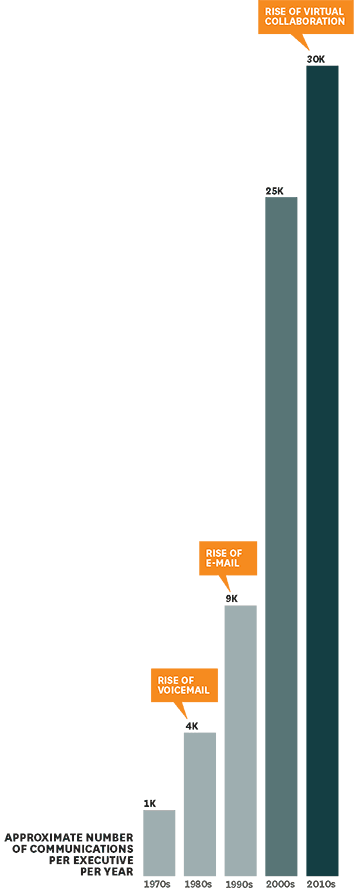Meetings: Why Less Is More
Drowning in meetings? Discover why less is more. Uncover the hidden costs of over-scheduling and strategies to reclaim your productivity in the era of remote work.

Why Meetings Destroy Productivity
If you are like me, you may have noticed that you are spending more and more of your precious work time in meetings. It’s almost as if our productivity is defined by how full our calendars are. The problem with this paradigm is that it is completely backwards. Having a week full of meetings might be the number one thing preventing you from achieving your peak productivity, and from a company’s perspective, the reason it can’t launch anything on time. Meetings, along with other workplace distractions prevent “deep work” from taking place, which is crucial for our ability to solve hard problems in creative ways. In this article, I will attempt to show you why a busy calendar is your number one enemy when it comes to making stuff happen.
Makers vs Managers
Admittedly, meetings are necessary for companies, schools, and communities to function. However, determining how useful meetings will be largely depends on your role within the organization and the number of meetings you attend. Consider the makers vs the managers. Makers are people who are in the trenches creating stuff. Makers apply substantial creativity and problem-solving skills over continuous periods, typically resulting in tangible outcomes. This could be a piece of software for a software engineer, a chapter in a book for a writer, or a business proposal for a CEO. Managers on the other hand manage teams and usually have some control over what the makers are making. Managers also tend to need more face-to-face meetings with clients and teams to form reasonable decisions.
The Maker / Manager Spectrum
In actuality, very few people are uniquely makers or managers. It is more likely that you have some maker work, and you also some managerial work. Perhaps in the early stages of a project, you need to spend more time meeting with clients to better define and delegate the work. This type of work lies closer to the manager side of the work spectrum. When all is decided and it's time to sit down and work, you put on your maker hat. For better or for worse, typically the more responsibility you assume, the closer to the manager end of the spectrum you lie. Even still, the world’s top CEOs still need time to exercise their creativity. Thus, it's not strictly about being a maker or a manager, but recognizing the importance of each role. Balancing managerial responsibilities with time for creative, maker-oriented tasks is essential. To truly enhance productivity, one must understand this delicate balance and strive to minimize disruptions.
Why We Need Deep Work?
Making is best done through “deep work”. Coined by computer science professor Cal Newport of Georgetown University, deep work is the batching of hard but important intellectual work into long, uninterrupted sessions. Cal argues that High-Quality Work Produced = (Time Spent) x (Intensity of Focus). There is scientific evidence to support this claim as well. In a 2009 paper intriguingly titled, ‘Why Is It So Hard to Do My Work?’ business professor Sophie Leroy introduced an effect she called attention residue. In this study, Leroy identifies a key problem through her research; when you switch from task A to task B, your attention does not instantly follow. Instead, a portion of your attention remains focused on the previous task. Attention residue also occurs when we leave tasks unfinished. This evidence further supports the above formula and provides insight into why long periods of uninterrupted, focused work leads to better outcomes.
Intensity > Time
In his book Deep Work, Cal Newport examined 50 “ultra high scoring” undergraduate students from top universities. These students often spent less total time studying than their counterparts but understood the importance of intensity in their work. These students went out of their way to maximize concentration, thereby significantly reducing the amount of time needed for high academic achievement.
Adam Grant is the youngest ever full professor at The Wharton School of the University of Pennsylvania as well as a #1 New York Times bestselling author. He is consistently ranked as one of, if not the best teachers at Wharton and is the recipient of multiple teaching awards. Grant batches his work and teaching throughout the year. He stacks all his teaching in the fall semester so that he can focus 100% of his attention on his students. This allows Grant to focus on his research and writing throughout the rest of the year. Deep work is not just beneficial to scientists and academics. It plays an equally important role in creative endeavours. From Mark Twain to J.K Rowling, accomplished authors throughout history have retreated to physically isolating spaces to enable distraction-free writing, all of which has led to some of history’s classic literature. Impactful makers intuitively knew that deep work was the best way to achieve great things long before Leroy’s research proved it.
What Is The Cost Of Switching?
You may already intuitively feel that context switching comes with a mental cost, but this loss of efficiency also comes with financial consequences. According to physiologist Gerald Weinberg, when working on two tasks simultaneously, the effort spent on each task is not split 50% each, it is 40%. There is a loss of 20% for each extra task you add to your agenda. Even scarier, when you take on more than two tasks at a time, you are spending more effort switching between tasks than you are actually doing the work.

For most organizations, time is literally money. The financial loss of task switching can be calculated with the following format.
Cost of added task = (task number * 0.20) * Daily salary of worker- The average salary of a tech worker in the bay area is $140,000 a year, coming out to roughly
$538.5 a day(assuming 250 working days a year) - Therefore, the cost of working on only two tasks for this person would be about $107.7 a day for only one individual.
- This amasses a yearly cost of roughly
$28,000 a year. Imagine how quickly this cost grows with all employees and tasks.
Harvard extrapolated this idea, applied it to meetings, and developed the Meeting Cost Calculator to estimate the cost of adding a new meeting to a schedule. In the example below, you can see that adding a simple 30-minute meeting with five people, where each person makes $100,000, will cost $175.

Adding meetings to your organization's calendar should be viewed as a consumption of company resources in the same way that salaries and office costs are viewed. Not only do they disrupt the ability for employees to engage in deep work, but they also reduce the efficiency of each attendee in a way that directly affects the bottom line.
You Are Not Crazy, You Are Attending More Meetings
A study conducted by Harvard Business School that analyzed the emails and meetings of 3.1 million people in 16 global cities, found that despite a decrease in meeting duration, people attended 13% more meetings, and the invite lists grew by 2 people since the start of the pandemic. Other noteworthy findings were a 5.2% increase in emails sent per day, as well as an increase in email participants. Scariest of all was that the average workday has increased by 8.2% (48.5 minutes) since the pandemic forced more companies to work remotely. Professor Sadun suspects the longer workday is a result of more interruptions either at home or at work.


Virtual Meetings Cause More Fatigue
With the push for more remote work, meetings might be even more detrimental. The Stanford Virtual Human Interaction Lab confirmed that prolonged periods of video conferencing actually leave participants more tired than if they had done the meeting in person. The term for this is “zoom fatigue”, and the researchers identified four contributing factors to this effect.
- Zoom meetings require excessive amounts of eye contact which is abnormal and increases stress.
- Looking at yourself in a meeting makes you more self-critical which is taxing.
- Zoom meetings limit movement which inhibits cognition.
- Zoom meetings cause participants to exaggerate physical and verbal cues that would normally be instinctual.
Given the prevalence of Zoom meetings along with the recently discovered mental effects, researchers are developing the Zoom Exhaustion & Fatigue Scale (ZEF scale) to help measure how much fatigue people are experiencing in virtual meetings. Although this tool is in its preliminary stages, hopefully metrics like this can be used to help create better tools in the future and combat the negative effects of video conferencing we all experience today.
Bigger Is Not Better
If someone is even slightly involved or interested in a topic, chances are they will be on the invite list to a meeting discussing the topic. Or perhaps you got added once to a reoccurring meeting and now you keep attending every week. It’s easier than ever to include people in discussions and it often feels like the right thing to do, because after all, what if they miss something important? The problem with adding more people to a team/discussion is that it has negative effects on that group's ability to produce. After nearly 50 years of studying team performance, the late Harvard professor J. Richard Hackman concluded that the optimal team size was between four and six people. After 10 people were added to a task, the performance had a significant drop off. Hackman attributes this to the overwhelming cognitive load that adding more members places on individuals within the group. This theory seems to be true in practice as well. A Harvard Business School study conducted by Melissa Valentine and Amy Edmondson on a large hospital’s emergency department demonstrated how effective pruning the team size can be. A large set of doctors and nurses were divided into “pods'' of six personnel with one lead physician. The results were astonishing. After the pods, patient throughput time (the time from hospital admission to discharge) plummeted by about 40%, from about eight hours (8.34) to five hours (5.29) per patient without an increase in staff. Of course, this is a more efficient use of staff and resources, but this also represents a significant improvement in the patient experience. It’s remarkable to see what a massive improvement can be made from such a small structural change. It is probable that the same effect applies to meetings. Having a large group of attendees inevitably means that someone will not be adding or gaining value from the meetings. Attending a meeting you are not needed in also means you are adding more to think about when perhaps your mental energy would best be applied elsewhere.
Solution
To summarize these are the general issues that arise from meetings:
- Meetings disrupt the ability of makers to have periods of uninterrupted focus, leading to poor results and reduced time spent working on tasks.
- Meetings introduce task switching, which in turn wastes time and costs organizations time and money.
- Virtual meetings are exhausting.
- Meeting attendance is increasing which adds unnecessary cognitive load to employees.
Given the fact that meetings are on the rise, it seems like we might be doomed. Luckily, there are systemic steps that can be taken to alleviate some of the pain points caused by meetings.
Adopt a Maker Schedule
Made famous by Paul Graham, co-founder of Y Combinator (the most successful technology accelerator of all time) and the first ever SAAS (software as a service) company, the maker schedule is meant to solve the very problem of meeting overload. The maker schedule was forged in a technology context where early-stage startups were working tirelessly to ship features and find product market fit. As discussed above, meetings impose a higher cost on the makers than they do on the managers. A manager's schedule divides the day into many chunks, typically one-hour intervals or sometimes even 30-minute intervals. For a manager, scheduling meetings is simply a matter of finding an available time slot. In contrast, a maker schedule thrives on as few interruptions as possible, typically dividing the day into two parts. For a maker, a single meeting can blow up the entire day, breaking up the afternoon into two small units that are too small to achieve anything difficult. Graham also points out that a meeting adds more burden on the maker since they need to remember to attend whereas a busy manager almost always has something to attend at the top of the hour, it’s just a matter of what. In addition to breaking up the morning or afternoon, there is a hidden effect. If a maker knows that their afternoon will be interrupted, they may be less willing to tackle ambitious problems that day. Y Combinator runs on a maker schedule which has allowed them to discover and grow some of the world's leading companies like Airbnb, Reddit, Dropbox and many more. Most businesses are complex and require a minimum level of collaboration. So, how can a company achieve a better balance between the maker and manager schedules?

Source: https://blog.nuclino.com/makers-don-t-let-yourself-be-forced-into-the-manager-schedule
Themed Days
Dedicating a day to one or two outcomes can be a great way to batch work or meetings such that it allows for the maximum amount of focus. Shifting all of your team's meetings into one day (or two if you have to) better optimizes for the maker schedule. It is a more efficient use of time to have a morning full of meetings, rather than having one or two that break the morning into unusable chunks. In this scenario, you might as well attend another meeting. By condensing the meetings into one or two days, the rest of the week becomes more open and the potential to get deep, hard work done, dramatically increases. Even if you can’t consolidate all your meetings into one or two days, batching similar work into longer periods is beneficial. A side effect to consider is that everyone is working under the same schedule, thus reducing the number of obligations one needs to hold in their head and ensuring that everyone's expectations of timelines are aligned. No-meeting Wednesdays have become increasingly popular ever since Facebook adopted them as a way to guarantee that everyone at the company had at least one day to solve hard problems. Steps like these go a long way when it comes to protecting precious periods of work time. No matter what you do, random, mid-day meetings should be avoided. Instead, look for opportunities to meet on an already packed day or bring the discussion into an adjacent meeting.
Don’t Invite Everyone And Their Dog To The Meeting
Simply put, if you do not speak in a meeting, you need to question the need for your attendance. Of course, you can watch lectures and live streams, but just attending someone's random morning standup is not going to add much to your day. We all read the first chapter (right?), trimming the extras from your meetings is an effective use of people's time and it focuses the group's attention. Every so often, do an audit of all your obligations and see if some could be pruned, or if you are the organizer, check in with attendees to see if they would still like to attend.

Time Is Money
People tend to get paid based on time – that’s a fact. If you’re going to pay someone to do something, you should also be conscious of how much time they are spending on that task. You wouldn’t spend all your company's money without a budget, why spend all your time on meetings? Treating time like your money and budgeting it can make better use of the scarcest resource. Ford was famous in 2006 for using a zero-based time budget, where all new meetings were subtracted from the existing scheduled time. This is a good way to not distrust everything too much but ensure that booking meetings doesn’t run rampant.
Office Hours
A good alternative to meetings is office hours. Office hours are when someone dedicates time on a regular basis for discussion. This sounds an awful lot like a meeting, the distinction being that office hours require attendees to sign up in advance. Only those who have something specific to discuss will sign up, freeing the rest of the group to do as they please. The added friction focuses the discussion and generally leads to tangible outcomes. If no one signs up for your office hours then you’re in luck, you just saved yourself a meeting. Paul Graham (the person who coined the term maker schedule) adopted this exact strategy to free himself of useless meetings while still making time for valuable collaboration. Office hours also give more control to the organizer to schedule them at convenient times that don’t break up their day into useless chunks. Even if the office hour times interrupts the attendee's schedule, this cost must be worth it to them since they scheduled the appointment in the first place. Adopting office hours to supplement traditional meetings can be an effective strategy to batch work, remove redundant attendees, and move towards a maker schedule, while still allowing space for productive collaboration.
Summary
It’s time to stop seeing busyness as a sign of productivity because in most cases, it is a hindrance. Instead, organizations should view the use of people's time as the consumption of resources. There is no silver bullet when it comes to eliminating useless meetings, but a progressive adoption of some of the strategies mentioned above will help. Even being conscious of the negative effects that meetings can have on productivity will help shift corporate culture and give back more precious time to the makers.